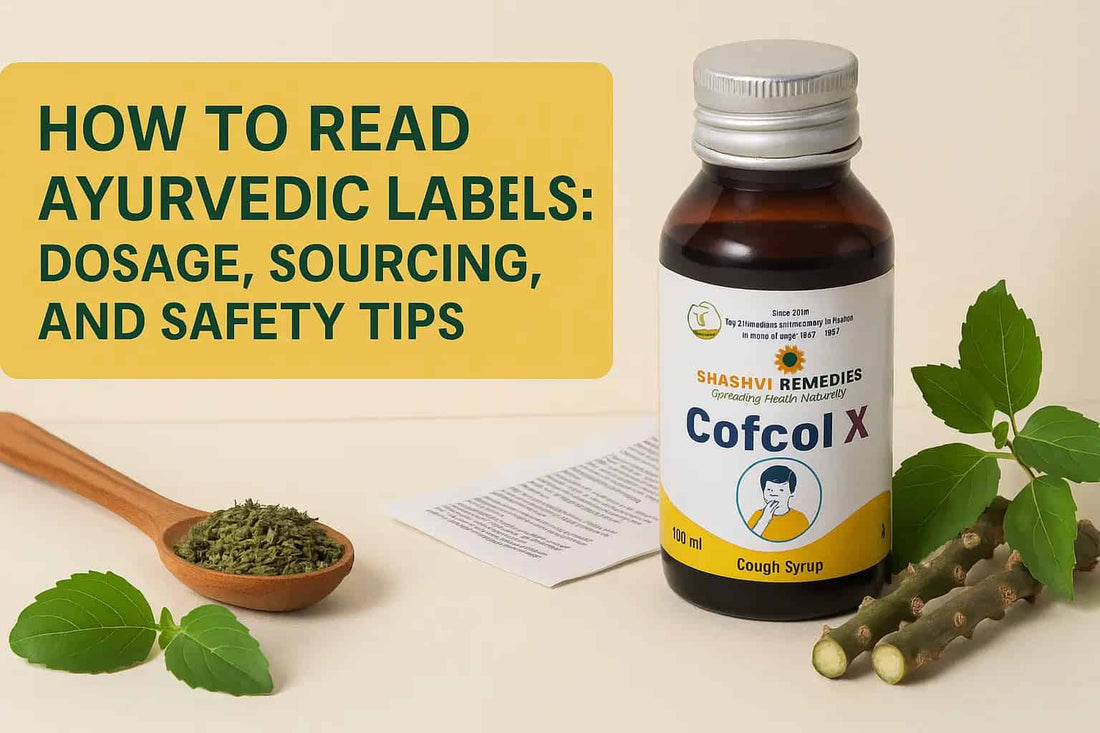
How To Read Ayurvedic Labels: Dosage, Sourcing, and Safety Tips
Share
Introduction
Every year, World Patient Safety Day (Sept 17) reminds us that safe health practices save lives. While Ayurveda has become a trusted system of natural healing worldwide, many first-time users often find themselves confused by product labels.
👉 How much should I take?
👉 Are these Sanskrit names safe herbs?
👉 Which certifications matter?
If you’ve asked yourself these questions, you’re not alone. Ayurvedic label literacy is an essential skill for safe, effective use of herbal products. In this guide, we’ll simplify how to read Ayurvedic labels—from dosage to sourcing—so you can make confident, informed choices for your family’s wellness.
The Challenge of Ayurvedic Label Literacy
For many wellness seekers, the excitement of trying Ayurveda quickly meets the confusion of reading labels. Some common struggles include:
-
Unclear dosage instructions that leave users unsure of how much to take.
-
Ingredient names in Sanskrit or Latin, making it hard to recognize herbs.
-
Trust issues: “Is this authentic? Is it really safe?”
Why does this matter? Misunderstanding labels can reduce product effectiveness or even cause misuse. To unlock Ayurveda’s full benefits, reading labels wisely is key.
What Ayurveda Teaches About Safety
Ayurveda has always emphasized responsible, mindful healing.
-
Yukti (wise application): Proper guidance ensures safe, effective results.
-
Matra (dosage): Even the best herb must be taken in the right amount.
-
Pathya (diet & lifestyle): Safe use extends beyond the medicine to how you eat, rest, and live.
-
Ahara Dravya Shuddhi (purity of sourcing): Herbs should be fresh, clean, and ethically sourced.
This ancient wisdom is still relevant today—and modern labeling exists to support these principles.
Practical Tips: How To Read Ayurvedic Labels Safely
*(Pro Tip: Print or save this as your Ayurvedic Label Checklist.)
1. Dosage Instructions
-
Look for the recommended amount and frequency.
-
Dosage may vary by age group—always follow the label or consult a physician.
2. Ingredients List
-
Identify key herbs (like Tulsi, Ashwagandha, and Giloy).
-
Look for standardized extracts or percentages.
-
Ensure there are no allergens or hidden additives.
3. Certifications
-
Check for GMP (Good Manufacturing Practices), ISO, and FSSAI marks.
-
These prove the product meets quality and safety standards.
4. Sourcing Information
-
Authentic labels often highlight sustainably harvested herbs.
-
Look for transparency about origin (India, Himalayas, etc.).
5. Warnings & Usage Notes
-
Watch for age restrictions (children, elderly).
-
Pregnancy & lactation disclaimers matter—Ayurveda is natural, but safety comes first.
6. Expiry & Batch Number
-
Ensure your product is within the expiry date.
-
Batch numbers allow traceability back to production.
✅ If a label is missing these details, think twice before buying.

Shashvi Ayurveda’s Commitment to Safety
At Shashvi Ayurveda, patient safety isn’t just a checklist—it’s a core philosophy.
-
Certified Excellence: All products follow GMP, ISO, and FSSAI standards.
-
Transparent Sourcing: Herbs are collected ethically, ensuring purity and potency.
-
Clear Labels: Dosage, usage, and safety instructions are printed in simple, easy-to-read formats.
👉 Explore Shashvi Ayurveda’s Certifications ➝
This way, every customer feels empowered, not confused.
Quick Checklist for Readers
Before you buy any Ayurvedic product, remember this:
✅ Check dosage instructions
✅ Look for GMP/ISO/FSSAI certifications
✅ Verify ingredients & sourcing
✅ Read the expiry date clearly
✅ Choose trusted brands with transparency
(Visual idea: A small “Before You Buy Ayurveda” checklist box for the blog)
Conclusion
Ayurveda is a science of balance, wisdom, and safety. By learning how to read labels carefully, you’re not only making better purchase decisions but also taking charge of your health journey.
Safe Ayurveda is responsible Ayurveda—and with trusted brands like Shashvi Ayurveda, you can enjoy wellness with complete confidence.
✨ Take the first step towards safe healing. Explore Shashvi Ayurveda’s certified products today.
FAQ Section
Q1. How do I know if an Ayurvedic product is safe?
Check for GMP, ISO, and FSSAI certifications, dosage clarity, and expiry date.
Q2. What certifications should I look for on labels?
Look for GMP, ISO, FSSAI, or AYUSH approvals in India.
Q3. Why is dosage important in Ayurveda ?
Because Ayurveda believes in Matra (right quantity)—too little won’t work, and too much may cause imbalance.
Q4. Can Ayurvedic products be taken with modern medicines?
Yes, but always consult a physician for safe combinations.
Q5. What if ingredients are listed in Sanskrit?
Many brands include English/common names too. Use Google or brand resources to cross-check herb benefits.
